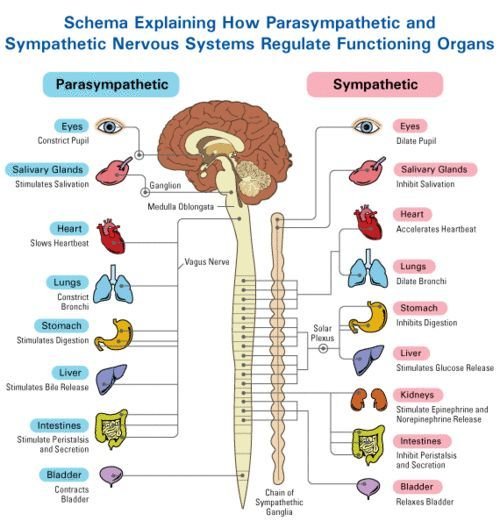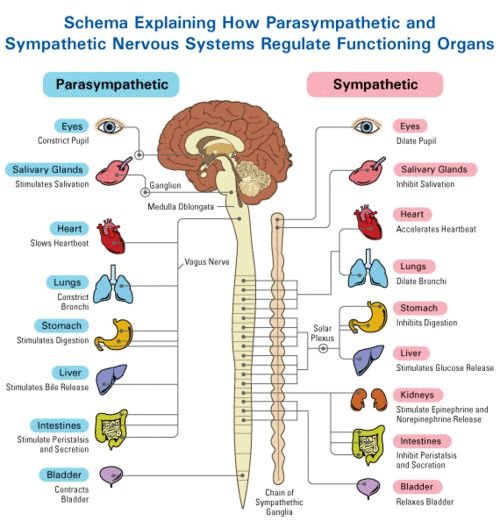
Speeding Up Your Body’s Healing
Sympathetic vs Parasympathetic functions of the nervous system:
Our nervous system has 2 interweaving sides: excitatory and vegetative. The excitatory side takes care of emergencies and the vegetative rest and regeneration. When we are stuck in a chronic tension pattern from a past accident or incident or a prolonged period of unremitting stress our ability to heal ourselves is seriously impaired. A new client came in for a free neuromuscular assessment/consultation. She’d been such a hard driving producer that her whole nervous system collapsed into chronic fatigue and inability to heal. The result was systemic infections that wouldn’t heal. The antibiotics further destroyed her gut biome and compromised her ability to take nutrition out of her food. She put on weight and had no energy for exercise. The end point was extreme: bed ridden for 2 years, too weak to walk, with PTSD from all the attempted interventions. This sketch of her situation (many details have been left out) is a perfect description of the failure to thrive that is marked by a fixation in the sympathetic side of the nervous system.
What the Parasympathetic side of the Autonomic Nervous System does:
- Meditation; enables you to reach states of at oneness.
- Relaxation; the ability to calm the mind.
- Digestion; secretion of enzymes and moving of the bowel
- Restoration; the efficiency and priorities of our body’s cellular metabolism are directly affected by whether we are at ease or anxious
- Sleep; the ability to access the deep sleep states of youth.
- Cell regeneration; all the metabolic chemistry that is used in healing and making new tissue.
What the Sympathetic nervous system does:
- Constricts blood vessels; raises blood pressure
- Shortens breath and limits it to the chest muscles
- Contracts pupils and produces focused “tunnel vision”
- Reverts to reactive responses based on past experience
- Inhibits higher brain functions (conceptual, integrative, problem solving and creativity)
- Suppresses immune response
- Disintegrates learned, refined movements and smooth muscle tone (colon)
- Produces physical awkwardness resulting in loss of self esteem
- Difficulty focusing and concentrating
- Difficulty falling or staying asleep or waking up still tired
Chronic Stress creates Sympathetic Hyper-arousal or Hyper-vigilance. Muscles are tight constantly in an overall hypertension ready for the need to fight, flight or freeze; always “at the ready.”
Areas expressive of the “the startle reflex” such as the back of the neck and elevation of the shoulders, sub-occipitals, eyes, low back, calf muscles, psoas and iliacus maintain the most tension.
The end result:
- Chronic tension and pain in muscles, especially those expressive of the startle reflex
- High levels of stress hormones and tension over time create high fluid levels in the tissue.
- Stiff, sore muscles, poor circulation, taut, pale and thick skin
- High fluid levels produce poor cellular nutrition, sluggish energy metabolism, poor recovery time from activity, and cell wall fragility.

